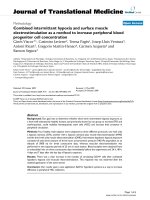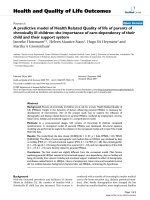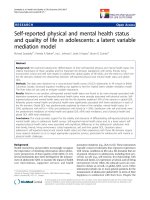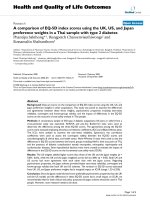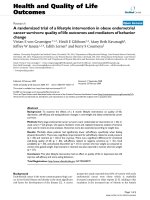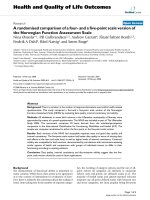báo cáo hóa học:" A biregional survey and review of first-line treatment failure and second-line paediatric antiretroviral access and use in Asia and southern Africa" pot
Bạn đang xem bản rút gọn của tài liệu. Xem và tải ngay bản đầy đủ của tài liệu tại đây (237.92 KB, 8 trang )
RESEARCH Open Access
A biregional survey and review of first-line
treatment failure and second-line paediatric
antiretroviral access and use in Asia and
southern Africa
TREAT Asia Pediatric HIV Observational Database (TApHOD)
1*
,
The International Epidemiologic Databases to Evaluate AIDS (IeDEA) Southern Africa Paediatric Group
2,3
Abstract
Background: To better understand the need for paediatric second-line antiretroviral therapy (ART), an ART
management survey and a cross-sectional analysis of second-line ART use were conducted in the TREAT Asia
Paediatric HIV Observational Database and the IeDEA Southern Africa (International Epidemiologic Databases to
Evaluate AIDS) regional cohorts.
Methods: Surveys were conducted in Apr il 2009. Analysis data from the Asia cohort were collected in March 2009
from 12 centres in Cambodia, India, Indonesia, Malaysia, and Thailand. Data from the IeDEA Southern Africa cohort
were finalized in February 2008 from 10 centres in Malaw i, Mozambique, So uth Africa and Zimbabwe.
Results: Survey responses reflected inter-regional variations in drug access and national guideli nes. A total of 1301
children in the TREAT Asia and 4561 children in the IeDEA Southern Africa cohorts met inclusion criteria for the
cross-sectional analysis.
Ten percent of Asian and 3.3% of African children were on second-line ART at the time of data transfer. Median
age (interquartile range) in month s at second-line initiation was 120 (78-145) months in the Asian cohort and 66
(29-112) months in the southern African cohort. Regimens varied, and the then current World Health Organization-
recommended nucleoside reverse transcriptase combination of abacavir and didanosine was used in less than 5%
of children in each region.
Conclusions: In order to provide life-long ART for children, better use of current first-line regimens and broader
access to heat-stable, paediatric second-line and salvage formulations are needed. There will be limited benefit to
earlier diagnosis of treatment failure unless providers and patients have access to appropriate drugs for children to
switch to.
Background
An estimated 2.5 million children worldwide are living
with HIV [1], and more than 354,000 of them were on
antiretroviral treatment (ART) at the end of 2009. Glo-
bal paediatric treatment coverage is estimated at 28%
after applying revised World Health Organization
(WHO) ART initiation criteria [1,2]. Once children are
on treatment, the cumulative risk of treatment failure
continues to increase over time. Social support, nutri-
tional supplements, counselling, medication records,
home-based care and transportation reimbursements are
only a few of the many resources that are used to pro-
mote adherence to delay this outcome.
Despite being in early stages of the paediatric ART
scale up, children are already failing treatment and
needing second-line regimens. Current United Nations
estimates of paediatric second-line use in low- and mid-
dle-income countries (LMICs; outside of the Americas)
are around 3% [1]. However, this is much lower than in
* Correspondence:
1
TREAT Asia/amfAR - The Foundation for AIDS Research, Bangkok, Thailand
Full list of author information is available at the end of the article
TApHOD and IeDEA Journal of the International AIDS Society 2011, 14:7
/>© 2011 TREAT Asia Paediatric HIV Observational Database (TApHOD) and The International Epidem iologic Databases to Evaluate AIDS
(IeDEA) Southern Africa Paediatric Group; licensee BioMed Central Ltd. This is an Open Access article distribute d under the terms of the
Creative Commons Attribution License (http:/ /creativecommons.org/licenses/by/2.0), which permits unrestricted use, distribution, and
reproduction in any mediu m, provided the original work is properly cited.
single cohort reports in settings where ART has been
avail able for l onger periods of time. A survey of 17 cen-
tres in LMICs in A sia reported that 20% of the more
than 3600 children under care were alrea dy past their
first ART regimens [3]. Other single-institution cohorts
have reported as much as 5.8% (South Africa [4]), 9%
(Thailand [5]), and 19.4% (south India [6]) of patients
switching to second-line regimens.
Evidence-based strategies for selecting second-line
regimens are needed, but are also dependent on local
ant iretroviral (ARV) options. Children have consistently
faced greater disadvantages with regards to the availabil-
ity of ARV formulations that can be dosed and delivered
to children, and that are safe to use during growth and
development [7,8].
To better understand the growing need for paediatric
second-line ART, we conducted a survey of two regional
cohorts - in Asia and souther n Africa - to determine
second-line use and ARV access, and compare nationally
recommended regimens to explore how regimen
sequencing is being approached in these regions.
Methods
Survey
A survey regarding second-line ART use was conducted
in the TREAT Asia Pediatric HIV Observational Data-
base (TApHOD) and the International Epidemiologic
Databases to Evaluate AIDS (IeDEA) Southern Africa
regional cohorts in April 2009. TApHOD was estab-
lished in 2008 and includes 16 clinical centres in six
countries, 12 of which currently submit patient-level
data to the cohort study (Table 1). The programme is
coordinated by TREAT Asia/amfAR (Bangkok, Thai-
land) with data management support from the National
Centre in HIV Epidemiology and Clinical Research
(NCHECR; Sydney, Australia). IeDEA Southern Africa
was formed in 2007, and includes 1 0 clinical sites that
provide ART for children in four countries, all of which
submit data to their cohort study. It is a research colla-
boration coordinated by the University of Cape Town
(South Africa) and the University of Bern (Switzerland).
Site-level questions queried access to nucleoside/
nucleotide reverse transcriptase inhibitors (NRTI/
NtRTIs) and protease inhibitors (PIs) commonl y used in
internationally recommended ART regimens. Drug
access was designated as “ eas y” (i.e., regular and consis-
tent access and supply), “somewhat difficult” (i.e., occa-
sional difficulties in accessing and/or obtaining),
“difficult ” (i.e., frequent difficulties in acce ssing and/or
obtaining), or “cannot or d o not access” (i.e., drug was
not available or clinicians did not use). Nationally
recommended paediatric ART regimens were obtained
from individual country guidelines, when available, or by
self-report from site principal investigators.
Observational cohort data
In each regional cohort study, partici pating sites submit
anonymized, patient-level data to their regional data
management centres for data cleaning and analysis.
TApHOD data are submitted twice a year. Data
included in this survey were collected in March 2009
from 12 centres in Cambodia, India, Indonesia , Malaysia
and Thailand. Data from the IeDEA S outhern Africa
cohort were finalized in February 2008 from 10 centres
in Malawi, Mozambique, South Africa and Zimbabwe.
Cross-sectional data on first- and second-line ART use
in children who were alive, on ART, and actively under
care as of the data submission date were eligible for
inclusion. Children in the cohort who had previously
been documented to have died, been transferred out of
the site, or were lost to follow up were consequently
excluded from the analysis.
In order to more accurately reflect clinical outcomes
with current pa ediatric ART management practic es
using highly active three-drug regimens and to avoid
potential misclassification of second-line regimens, chil-
dren also were excluded in the following circumstances:
1) first ART regimens were unknown or missing from
the database; 2) first ART regimens we re either mono-
or dual-therapy; or 3) first ART regimens contained
didanos ine. Children using didanosine were excluded in
order for the analysis cohort to more closely reflect
standard, WHO-recommended first-line regimens [9].
Second-line switches were defined as a change in two
or more ARVs, including a class switch, i.e., from non-
nucleoside reverse transcriptase inhibitors (NNRTIs) to
PIs or visa versa, o r if a s ingle-drug class switch was
made on t he basis of reported treatment failure; regi-
mens could not be reverted for at least 24 weeks to
avoid including chang es due to temporary stock outs.
Descriptive statistics were conducted in SAS and
STATA.
Results
All sites in TREAT Asia (n = 16) and IeDEA Southern
Africa (n = 10) responded to the survey (Table 1).
Nationally recommended first-line ART regimens were
consistent with WHO guidelines, and were most com-
monly combinations of stavudine or zidovudine with
lamivudine and nevirapine or efavirenz. The four Malay-
sian hospitals allowed for the use of didanosine in the
first-line NRTI backbone. In addition, boosted PIs were
recommended in some centres when previous NNRTI
exposure was known (Cambodia, China, Mozambique).
South Africa recommended a boosted PI for first-line
treatment of all children under three y ears of age or
weighing less than 10 kilograms.
All recommended second-line regimen s for children
failing NNRTI-based first-line ART included ritonavir-
TApHOD and IeDEA Journal of the International AIDS Society 2011, 14:7
/>Page 2 of 8
Table 1 First- and second-line antiretroviral therapy regimens in use in TREAT Asia and IeDEA Southern Africa
Site Country Nationally recommended
paediatric first-line ART
regimen*
Nationally recommended
paediatric second-line ART
regimen after NNRTI
Most commonly used
second-line regimen in
current site cohort
TREAT Asia
National Center for HIV, AIDS,
Dermatology, and Sexually
Transmitted Infections
Cambodia d4T or AZT+3TC+NVP or EFV
If NNRTI exposure:
d4T+3TC+LPV/r
ABC+ ddI+LPV/r ABC+3TC+LPV/r
Beijing Ditan Hospital China d4T or AZT+3TC+NVP or EFV
If NNRTI exposure:
AZT+3TC+LPV/r
ABC+3TC+AZT+LPV/r ABC+3TC+AZT+LPV/r
YRG Centre for AIDS Research
and Education
India d4T or AZT+3TC+NVP or EFV <3 yr:
ABC+ddI+3TC+LPV/r
>3 yr:
TDF+3TC or FTC+LPV/r
TDF or ddI+3TC or FTC+LPV/
r
Cipto Mangunkusumo Hospital Indonesia d4T or AZT+3TC+NVP or EFV ddI+3TC+LPV/r ddI+3TC+LPV/r
Hospital Kuala Lumpur Malaysia <3 yr:
AZT+3TC or ddI+NVP
≥3 yr:
AZT+3TC or ddI+EFV
2 new NRTI+LPV/r d4T+3TC+LPV/r
Hospital Likas Malaysia <3 yr:
AZT+3TC or ddI+NVP
≥3 yr:
AZT+3TC or ddI+EFV
2 new NRTI+LPV/r d4T+ddI+LPV/r
Hospital Penang Malaysia <3 yr:
AZT+3TC or ddI+NVP
≥3 yr:
AZT+3TC or ddI+EFV
2 new NRTI+LPV/r –
Hospital Raja Perempuan Zainab Malaysia <3 yr:
AZT+3TC or ddI+NVP
≥3 yr:
AZT+3TC or ddI+EFV
2 new NRTI+LPV/r d4T+ddI+LPV/r
Chiang Mai University Medical
Centre
Thailand d4T or AZT+3TC+NVP or EFV ddI+ABC or 3TC+PI/r AZT+3TC+LPV/r
Chiang Rai Regional Hospital Thailand d4T or AZT+3TC+NVP or EFV ddI+ABC or 3TC+PI/r AZT+3TC+LPV/r
HIV-NAT Thailand d4T or AZT+3TC+NVP or EFV ddI+ABC or 3TC+PI/r AZT+3TC+LPV/r
Khon Kaen University Medical
Centre
Thailand d4T or AZT+3TC+NVP or EFV ddI+ABC or 3TC+PI/r AZT+ddI+LPV/r
Siriraj Hospital Thailand d4T or AZT+3TC+NVP or EFV ddI+ABC or 3TC+PI/r AZT+ddI+LPV/r
Children’s Hospital 1 Vietnam d4T+3TC+NVP ABC+ddI+LPV/r –
Children’s Hospital 2 Vietnam d4T+3TC+NVP ABC+ddI+LPV/r ABC+ddI+LPV/r
National Hospital of Pediatrics Vietnam d4T+3TC+NVP ABC+ddI+LPV/r ABC+ddI+LPV/r
IeDEA Southern Africa
Lighthouse Clinic Malawi d4T+3TC+NVP ABC+ddI+LPV/r AZT+3TC+LPV/r
Paediatric Day Hospital, Maputo Mozambique d4T or AZT+3TC+NVP or EFV
If NNRTI exposure:
d4T or AZT+3TC+LPV/r
ABC+ddI+LPV/r None
Rahima Moosa Mother and Child
Hospital
South Africa <3 yr/10 kg:
d4T+3TC+LPV/r
>3 yr/10 kg:
d4T+3TC+EFV
AZT+ddI+LPV/r ABC+3TC+LPV/r
Gugulethu Community Health
Centre
South Africa <3 yr/10 kg:
d4T+3TC+LPV/r
>3yr/10kg:
d4T+3TC+EFV
AZT+ddI+LPV/r AZT+ddI+EFV or LPV/r
ABC+3TC+LPV/r
Harriet Shezi Clinic South Africa <3 yr/10 kg:
d4T+3TC+LPV/r
>3 yr/10 kg:
d4T+3TC+EFV
AZT+ddI+LPV/r AZT+ddI+LPV/r
TApHOD and IeDEA Journal of the International AIDS Society 2011, 14:7
/>Page 3 of 8
boosted lopinavir. The NRTI combination varied from
the WHO-recommended combination of abacavir and
didanosine to substituting with another thymidine
analogue (i.e., zidovudine for stavudine). A third of the
sites continued lamivudine in second-line regimens.
Malaysian and South African sites, representing 42% of
all sites, had specific national recommendations for sec-
ond-line regimens after initial PI failur e that advised use
of two new NRTIs and either nevirapine or efavirenz
(data not shown).
There was some variability in levels of drug access
between the regions (Table 2). IeDEA S outhern Africa
had better access to abacavir and r itonavir suspension;
TREAT Asia sites had better access to tenofovir and
paediatric, heat-stable boosted lopinavir tablets.
Although all of the African sites had access to the adult
version of the boosted lopinavir, 80% found it either dif-
ficult to access the liquid or paedia tric formulation of
the tablet, or did not use it for their patients. This was
related to delays at the time of the survey in the drug’s
approval by the South African Medicines Cont rol Coun-
cil that have since been resolved.
A total of 1301 children in the TREAT Asia and 4561
children in t he IeDEA Southern African cohorts met
inclusion criteria for the cross-sectional analysis (Tables 3
and 4). Although stavudine was infrequently used in Asia,
it was part of the first-line regimen in 92% of children in
southern Africa. Ten percent of Asian and 3.3% of African
children were on second-line ART at the time of data
transfer. Asian children were on second-line ART for
longer periods and were older at the time of switch. Afri-
can children on second-line ART were more frequently
male (67%). Regimens varied widely, and the WHO-
recommended combination at the time of the data transfer
of abacavir and didanosine [10] was use d in less than 5%
of children in each region.
Discussion
The percentage of children on second-line in the IeDEA
Southern Africa cohort was similar to United Nations
estimates, but it was three times higher in the TREAT
Asia cohort. Although southern African data were col-
lected one year earlier, this marked difference may be
related to the longer history of paediatric ART in Asia
relative to the more recent scale up observed in south-
ern Africa.
In fact, we are likely to have underestimated the use of
second-line ART in the Asian cohort, since 18% of chil-
dren excluded from this analysis had a previous expo-
sure to mono- and dual-NRTI regimens. In addition,
these differences may be related to regional variation in
the availability of clear second-line switch criteria, and
broader access to viral load testing in Asia.
However,thesedatareflect only those currently on
second-line treatment. Estimates for how many children
are ready to switch to second-line ART now and projec-
tions for the future are critically needed in order to pre-
pare providers, governments and donors. If the need for
second-line ART is based on virologic failure alone, the
numbers in need would be much higher.
In Asia, 15% of children in a Cambodian study and 37%
of children in a Chinese s tudy had viral loads of more
than 1000 copies/ml after 12 months of first-line ART
[11,12]. An earlier Thai cohort reported that 17% of
Table 1 First- and second-line antiretroviral therapy regimens in use in TREAT Asia and IeDEA Southern Africa
(Continued)
Khayelitsha Community Health
Centre
South Africa < 3 yr/10 kg:
d4T+3TC+LPV/r
>3 yr/10 kg:
d4T+3TC+EFV
AZT+ddI+LPV/r AZT+ddI+LPV/r
McCord Hospital South Africa <3 yr/10 kg:
d4T+3TC+LPV/r
>3 yr/10 kg:
d4T+3TC+EFV
AZT+ddI+LPV/r AZT+ddI+LPV/r
Red Cross Children’s Hospital South Africa <3 yr/10 kg:
d4T+3TC+LPV/r
>3 yr/10 kg:
d4T+3TC+EFV
AZT+ddI+LPV/r AZT+ddI+EFV
Tygerberg Hospital South Africa <3 yr/10 kg:
d4T+3TC+LPV/r
>3 yr/10 kg:
d4T+3TC+EFV
AZT+ddI+LPV/r AZT+ddI+LPV/r
Newlands Clinic Zimbabwe AZT+3TC+NVP ddI+3TC+LPV/r d4T+3TC+NVP
*Content reflects current recommendations at the time of the survey. WHO first-line regimen recommendations at the time of the survey included two NRTIs
with one NNRTI or two NRTIs with one PI/r if the infant had previous NNRTI exposure [10,17]; second-line regimen recommendations after NNRTI failure included
two NRTIs with one PI/r or unboosted nelfinavir in limited circumstances.
d4T - stavudine; AZT - zidovudine; 3TC - lamivudine; NVP - nevirapine; EFV - efavirenz; ABC - abacavir; ddI - didanosine; LPV/r - ritonavir-boosted lopinavir; TDF -
tenofovir; FTC - emtricitabine; NRTI - nucleoside reverse transcriptase inhibitor; NNRTI - non-nucleoside reverse transcriptase inhibitor.
TApHOD and IeDEA Journal of the International AIDS Society 2011, 14:7
/>Page 4 of 8
children had vi rologic failure after 192 weeks of AR T [5].
Similarly, a study done in southern Africa using the cut-
off of more than 1000 copies/ml reported a cumulative
probability of failure by three years after ART initiation
of 19.3% [13], and a study of children and adolescents in
Uganda reported 26% with viral loads of more than 400
copies/ml after 12 months of treatment [14].
Even in settings where v iral load is routinely available,
paediatricians are less inclined to switch children who
have persistent viremia unless adherence to a new regi-
men can be assured and the benefits of a new regimen
outweigh the risks of running out of ART options.
Furthermore, when the initial regimen includes a
boosted PI, low-level viremia may not indicate resistance
to the PI. Most importantly, the decision to switch ART
at a young age in countries that only have two lines of
national ART regimens can leave children with no sup -
pressive regimens by adolescence. Tha t the median age
at switch in IeDEA Southern Af rica was 5.5 years was
especially concerning because of the lack of available
third-line options that these young children now have.
This may reflect the impact of NNRTI resistance after
prevention of mother to chil d transmission interven-
tions, which can also be a factor in ART management
after first-line PI failure in those infants who are started
on boosted lopinavir.
Another notable finding was that only 33% of the chil-
dren on second-line treatment in the southern African
cohort were female. However in an an alysis using the
same data of factors that predict switch to second-line
Table 2 Levels of access to commonly used second-line antiretroviral drugs in TREAT Asia and IeDEA Southern Africa
Categories of drug access
Antiretroviral* Easy to access Somewhat difficult to access Difficult to access Cannot or do not access
TA SA TA SA TA SA TA SA
ABC 38% 60% 6% 0 19% 30% 38% 10%
ddI 100% 90% 0 0 0 0 0 10%
TDF 50% 10% 38% 30% 0 10% 13% 50%
ATV 19% 10% 13% 0 6% 0 63% 90%
IDV 56% 10% 6% 10% 6% 20% 31% 60%
LPV/r, liquid 69% 80% 13% 20% 0 0 19% 0
LPV/r, paediatric tablet 50% 10% 0 10% 19% 10% 31% 70%
LPV/r, adult tablet 81% 100% 0 0 13% 0 6% 0
LPV/r, adult capsule 31% 60% 19% 20% 6% 0 44% 20%
NFV 6% 20% 13% 0 0 20% 81% 60%
RTV, liquid 13% 50% 19% 20% 19% 0 50% 30%
RTV, capsule 38% 50% 13% 30% 0 0 50% 20%
SQV 13% 10% 13% 10% 25% 30% 50% 50%
*any formulation unless noted otherwise.
TA - TREAT Asia; SA - IeDEA Southern Africa; ABC - abacavir; ddI - didanosine; TDF - tenofovir; ATV - atazanavir; IDV - indinavir; LPV/r - ritonavir-boosted lopinavir;
NFV - nelfinavir; RTV - ritonavir; SQV - saquinavir.
Table 3 Paediatric antiretroviral therapy (ART) utilization among children on first-line ART at data transfer in TREAT
Asia and IeDEA Southern Africa
TREAT Asia (N = 1164) IeDEA Southern Africa (N = 4412)
Female, N (%) 608 (52) Female, N (%) 2179 (49)
Most common regimens, N (%) Most common regimens
AZT+3TC+NVP 529 (46) d4T+3TC+EFV 2154 (49)
AZT+3TC+EFV 299 (26) d4T+3TC+LPV/r 979 (22)
d4T+3TC+NVP 183 (16) d4T+3TC+NVP 671 (15)
d4T+3TC+EFV 53 (5) d4T+3TC+LPV/r+RTV 128 (3)
AZT+3TC+LPV/r 33 (3) AZT+3TC+NVP 119 (3)
Median age, months (IQR) at start 85 (47-119) Median age, months (IQR) at start 56 (22-96)
Median age, months (IQR) at data transfer 129 (90-163) Median age, months (IQR) at data transfer 79 (43-119)
Median months (IQR) on regimen 38 (20-58) Median months (IQR) on regimen 19 (9-31)
TApHOD and IeDEA Journal of the International AIDS Society 2011, 14:7
/>Page 5 of 8
in southern Africa, gender was not predictive after
adjustment for age, duration on ART, disease se verity at
the time of failure and first-line regimen [13].
A wide range of second-line regimens was in use.
Unlike the United Nations data reporting that at least
46.7% of paediatric second-line regimens in the 59
LMICs it surveyed contained abacavir [1], this ARV was
infrequently used in either the TREAT Asia or the
IeDEA Southern Africa cohorts. Most of the second-line
regimens included recycling of a thymidine analogue
(i.e., zidovudine). It was unexpected that abacavir was
more difficult to access b y clinical sites in Asia despite
being part of the WHO-recommended second-line regi-
men. The relatively higher c ost of abacavir compared
with zidovudine may also be a deterrent to its use.
Access to a broader range of paediatri c ARVs is needed
in order to maximize the potency of s econd- and third-
line regimens, whenever possible.
Another outcome of this survey was t o document the
differences in use of stavudine between the regions.
Recent WHO recommendations for adult ART have
proposed setting up plans for phasing out stavudine by
2011 because of long-term toxicity with this drug [15].
Similar recommendations for children may also be justi-
fied [16]. Scaling up of paediatric treatment in many
developing countries depends on simple fixed-dose com-
binations and child-friendly adapted formulations, such
as dispersible tablets, improved palatability and heat-
stable formulations (for storage in tropical climates).
Examples include the need for ritonavir-boosted ataza-
navir and heat-stable ritonavir-boosted lopinavir in pala-
table paediatric formulations.
In addition, given the difficulties of accessing clean
water in many resource-limited rural settings, formula-
tions that require reconstitution should ideally be
avoided. Efforts are also needed to ensure that newer
drugs, such as raltegravir, darunavir and etravirine, are
also developed as heat-stable formulations and tested
for use in infants and young children as these represen t
important potential options for both, and for improv ing
first-line regimens and as salvage therapy.
Finally, improving access to effective paediatric treat-
ment also requires improved access to diagnostic tools,
including PCR for early infant diagnosis and more wide-
spread access to viral load technologies for early diagnosis
of treatment failure. Although rarely available, the role of
resistance testing in LMIC settings continues to be
unclear. Further research on when and how HIV genotyp-
ing in heavily experienced children can be cost-effective is
needed to identify possible strategies for its use.
Our data are limited by their cross-sectional nature
and depth. The potential impact of changes in drug
access and national or global paediatric treatment guide-
lines are difficult to assess from our surveys and the
regional databases. Additio nal detail on the durability of
first-line regimens in the children with treatment failure
is available for the southern Africa cohort in a previo us
publication [13], but has not yet been analyzed for the
Asian cohort. The survey on drug access did not sepa-
rate out drugs that could not be accessed from those
there were simply not used in the clinic.
The participating clinica l centres are also largely urban
referral centres, preventing generalization of these results.
However, these cohorts include some of the most experi-
enced patients in these regions, who are facing challenges
today that are expected to arise for all children as they age
into adulthood. The lessons we are learning from these
children’s experiences with ART can be used to better pre-
pare national-level programmes for the future.
Conclusions
Although better use of first-line drugs can delay failure
and improve second-line outcomes, the need for second-
line paediatric ART in LMICs will continue to grow. The
Table 4 Paediatric antiretroviral therapy (ART) utilization among children on second-line ART at data transfer in
TREAT Asia and IeDEA Southern Africa
TREAT Asia (N = 137) IeDEA Southern Africa (N = 149)
Female, N (%) 69 (50) Female, N (%) 49 (33)
Most common regimens, N (%) Most common regimens
AZT+3TC+LPV/r 31 (23) AZT+ddI+LPV/r 54 (36)
AZT+ddI+LPV/r 29 (21) AZT+ddI+EFV 17 (11)
ddI+3TC+LPV/r 15 (11) AZT+TDF+LPV/r 14 (9)
LPV/r+IDV 8 (6) ABC+3TC+LPV/r 12 (8)
d4T+ddI+LPV/r 7 (5) d4T+3TC+LPV/r 8 (5)
Median age, months (IQR) at start 120 (78-145) Median age, months (IQR) at start 66 (29-112)
Median age, months (IQR) at data transfer 146 (102-173) Median age, months (IQR) at data transfer 104 (62-143)
Median months (IQR) on regimen 17 (9-38) Median months (IQR) on regimen 12 (4-18)
AZT - zidovudine; 3TC - lamivud ine; NVP - nevirapine; d4T - stavudine; EFV - efavirenz; LPV/r - ritonavir-boosted lopinavir; ddI - didanosine; IDV - indinavir; ABC -
abacavir; TDF - tenofovir.
TApHOD and IeDEA Journal of the International AIDS Society 2011, 14:7
/>Page 6 of 8
availability of potent, less toxic ARVs for both first- and
second-line regimens must keep pace with children as
they transition to adolescence and adulthood. Ultimately,
therewillbelimitedbenefitto earlier diagnosis of treat-
ment failure unless providers and patients have access to
appropriate drugs for children to switch to.
Acknowledgements
TREAT Asia is a programme of The Foundation for AIDS Research, amfAR.
The TREAT Asia Paediatric HIV Observational Database (TApHOD) is
supported in part by grants from the Austrian AIDS Life Association, the U.S.
National Institutes of Health (National Institute of Allergy and Infectious
Diseases; Eunice Kennedy Shriver National Institute of Child Health and
Human Development) through the International Epidemiologic Databases to
Evaluate AIDS (Grant No.U01-AI069907). The National Centre in HIV
Epidemiology and Clinical Research is funded by The Australian Government
Department of Health and Ageing, and is affiliated with the Faculty of
Medicine, The University of New South Wales. IeDEA Southern Africa is
supported by the National Institute of Allergy and Infectious Diseases and
the Eunice Kennedy Shriver National Institute of Child Health and Human
Development (Grant No: U01 AI069924-01). The funders had no role in study
design, data collection and analysis, decision to publish, or preparation of
the manuscript.
We thank Isabelle Andrieux-Meyer, Janice Lee and Nathan Ford from
Médecins Sans Frontières for their contributions to the manuscript, and all
the children, caregivers and the staff in the participating centres who have
contributed to the IeDEA Asia-Pacific and Southern Africa collaborations. The
content of this publication is solely the responsibility of the authors and
does not necessarily represent the official views of any of the institutions
just mentioned.
Author details
1
TREAT Asia/amfAR - The Foundation for AIDS Research, Bangkok, Thailand.
2
School of Public Health and Family Medicine, University of Cape Town,
Cape Town, South Africa.
3
Institute of Social and Preventive Medicine,
University of Bern, Bern, Switzerland.
Authors’ contributions
All authors listed below have equally contributed to the study. All authors
have read and approved the final version of the manuscript.
Authors’ information
The TREAT Asia Paediatric HIV Network
V Saphonn* and S Saramony, National Centre for HIV/AIDS Dermatology and
STDs, Phnom Penh, Cambodia;
U Vibol* and S Sophan, National Pediatric Hospital, Phnom Penh, Cambodia;
J Tucker, New Hope for Cambodian Children, Phnom Penh, Cambodia;
FJ Zhang and N Han, Beijing Ditan Hospital, Beijing, China;
N Kumarasamy* and S Saghayam, YR Gaitonde Centre for AIDS Research and
Education, Chennai, India;
N Kurniati*‡ and D Muktiarti, Cipto Mangunkusumo General Hospital, Jakarta,
Indonesia;
SM Fong* and M Thien, Hospital Likas, Kota Kinabalu, Malaysia;
NK Nik Yusoff* and LC Hai, Hospital Raja Perempuan Zainab II, Kelantan,
Malaysia;
K Razali* and NF Abdul Rahman, Pediatric Institute, Hospital Kuala Lumpur,
Kuala Lumpur, Malaysia;
R Nallusamy* and KC Chan, Penang Hospital, Penang, Malaysia;
V Sirisanthana*and L Aurpibul, Chiang Mai University, Chiang Mai, Thailand;
R Hansudewechakul* and A Khongponoi, Chiangrai Prachanukroh Hospital,
Chiang Rai, Thailand;
P Lumbiganon* and P Kosalaraksa., Khon Kaen University, Khon Kaen,
Thailand;
G Jourdain, Program for HIV Prevention and Treatment, Chiang Mai,
Thailand;
J Ananworanich*† and T Suwanlerk, The Netherlands, Australia, Thailand
Research Collaboration (HIV-NAT), Bangkok, Thailand;
K Chokephaibulkit* and O Wittawatmongkol, Siriraj Hospital, Mahidol
University;
HK Truong* and DAN Mai, Children’s Hospital 1, Ho Chi Minh City, Vietnam;
CV Do* and MT Ha, Children’s Hospital 2, Ho Chi Minh City, Vietnam;
HV Bui *and VL Nguyen, National Hospital of Pediatrics, Hanoi, Vietnam;
ON Le, Worldwide Orphans Foundation, Ho Chi Minh City, Vietnam;
AH Sohn*, L Messerschmidt and J Pang, TREAT Asia, amfAR - The
Foundation for AIDS Research, Bangkok, Thailand;
DA Cooper, MG Law* and A Kariminia, National Centre in HIV Epidemiology
and Clinical Research, The University of New South Wales, Sydney, Australia;
*TApHOD Steering Committee member
† Current Steering Committee Chair; ‡ co-Chair
IeDEA Southern Africa Paediatric Group
Mary-Ann Davies, School of Public Health and Family Medicine, University of
Cape Town, South Africa;
Brian Eley, Red Cross Children’s Hospital and the School of Child and
Adolescent Health, University of Cape Town, Cape Town, South Africa;
Janet Giddy, McCord Hospital, Durban, South Africa;
Harry Moultrie, Institute for Sexual Reproductive Health, HIV and Related
Diseases, Faculty of Health Sciences, University of the Witwatersrand,
Johannesburg, South Africa;
Margaret Pascoe, Newlands Clinic, Harare, Zimbabwe;
Helena Rabie, Tygerberg Academic Hospital and University of Stellenbosch,
Cape Town, South Africa;
Karl Technau, Empilweni Service and Research Unit, Rahima Moosa Mother
and Child Hospital, University of the Witwatersrand, Johannesburg, South
Africa;
Gilles Van Cutsem, Khayelitsha ART Programme, Médecins Sans Frontières
and School of Public Health and Family Medicine, University of Cape Town,
Cape Town, South Africa;
Paula Vaz, Paediatric Day Hospital, Maputo, Mozambique ;
Ralf Weigel, Lighthouse Trust, Lilongwe, Malawi;
Robin Wood, Gugulethu Community Health Centre and Desmond Tutu HIV
Centre, Institute of Infectious Disease and Molecular Medicine, University of
Cape Town, Cape Town, South Africa
IeDEA Southern Africa Steering Group
Member sites: Anna Coutsoudis, PMTCT Plus, Durban, South Africa; Diana
Dickinson, Gaborone Independent Hospital, Gaborone, Botswana; Brian Eley,
Red Cross Children’s Hospital, Cape Town, South Africa; Lara Fairall, Free
State provincial ARV roll out, South Africa; Tendani Gaolathe, Princess Marina
Hospital, Gaborone, Botswana; Janet Giddy, McCord Hospital, Durban, South
Africa; Timothy Meade, CorpMed Clinic, Lusaka, Zambia; Patrick MacPhail,
Themba Lethu Clinic, Helen JosephHospital, Johannesburg, South Africa;
Lerato Mohapi, Perinatal HIV Research Unit, Johannesburg, South Africa;
Margaret Pascoe, Newlands Clinic, Harare, Zimbabwe; Hans Prozesky,
Tygerberg Academic Hospital, Stellenbosch, South Africa; Harry Moultrie,
Enhancing Children’s HIV Outcomes (Harriet Shezi Children’s Clinic, Chris
Hani Baragwanath Hospital, Soweto); Karl Technau, University of
Witwatersrand Paediatric HIV Clinics (Empilweni Service and Research Unit,
Rahima Moosa Mother and Child Hospital), Johannesburg, South Africa;
Gilles van Cutsem, Khayelitsha ART Programme and Médecins sans
Frontières, Cape Town, South Africa; Paula Vaz, Paediatric Day Hospital,
Maputo, Mozambique; Ralf Weigel, Lighthouse Trust, Lilongwe, Malawi;
Robin Wood, Gugulethu and Masiphumelele ART Programmes, Cape Town,
South Africa.
Central team: Matthias Egger, Beatrice Fatzer, Claire Graber and Olivia
Keiser, Institute of Social and Preventive Medicine, University of Bern, Bern,
Switzerland; Andrew Boulle, Morna Cornell, Mary-Ann Davies, Nicola Maxwell,
Landon Myer and Anna Grimsrud, School of Public Health and Family
Medicine, University of Cape Town, Cape Town, South Africa.
Competing interests
The authors declare that they have no competing interests.
Received: 30 November 2010 Accepted: 9 February 2011
Published: 9 February 2011
References
1. UNAIDS: UNAIDS Report on the global AIDS epidemic. Geneva 2010.
2. WHO: Towards Universal Access. Scaling up priority HIV/AIDS interventions in
the health sector. Geneva 2010.
3. Prasitsuebsai W, Bowen AC, Pang J, Hesp C, Kariminia A, Sohn AH: Pediatric
HIV clinical care resources and management practices in Asia: a regional
TApHOD and IeDEA Journal of the International AIDS Society 2011, 14:7
/>Page 7 of 8
survey of the TREAT Asia pediatric network. AIDS Patient Care STDS 2009,
24:127-131.
4. Jaspan HB, Berrisford AE, Boulle AM: Two-year outcomes of children on
non-nucleoside reverse transcriptase inhibitor and protease inhibitor
regimens in a South African pediatric antiretroviral program. Pediatr
Infect Dis J 2008, 27:993-998.
5. Puthanakit T, Aurpibul L, Oberdorfer P, Akarathum N, Kanjanavanit S,
Wannarit P, Sirisanthana T, Sirisanthana V: Sustained immunologic and
virologic efficacy after four years of highly active antiretroviral therapy
in human immunodeficiency virus infected children in Thailand. Pediatr
Infect Dis J 2007, 26:953-956.
6. Kumarasamy N, Venkatesh KK, Devaleenol B, Poongulali S, Mothi SN,
Solomon S: Safety, Tolerability and Effectiveness of Generic HAART in
HIV-Infected Children in South India. J Trop Pediatr 2009, 55:155-9.
7. Sohn AH, Ananworanich J: How can we simplify antiretroviral therapy in
children? Curr Opin HIV AIDS 2007, 2:426-430.
8. Sohn AH, Ananworanich J: Highly active antiretroviral therapy for
children with treatment failure. HIV Ther 2009, 3:485-499.
9. WHO: Antiretroviral therapy for HIV infection in infants and children: Towards
universal access: Recommendations for a public health approach-2010 revision.
Geneva 2010.
10. WHO: Antiretroviral therapy of HIV infection in infants and children in
resource-limited settings: Towards universal access, Recommendations for a
public-health approach. Geneva 2006.
11. Janssens B, Raleigh B, Soeung S, Akao K, Te V, Gupta J, Vun MC, Ford N,
Nouhin J, Nerrienet E: Effectiveness of highly active antiretroviral therapy
in HIV-positive children: evaluation at 12 months in a routine program
in Cambodia. Pediatrics 2007, 120:e1134-1140.
12. Zhang F, Haberer JE, Zhao Y, Dou Z, Zhao H, He Y, Cao GH: Chinese
pediatric highly active antiretroviral therapy observational cohort: a 1-
year analysis of clinical, immunologic, and virologic outcomes. J Acquir
Immune Defic Syndr 2007, 46:594-598.
13. Davies MA, Wood R, Van Cutsem G, Giddy J, Eley B, Rabie H, Moultrie H,
Technau K, Boulle A, (IeDEA-SA): Virologic failure and second-line
antiretroviral therapy (ART) in children in South Africa: the international
epidemiologic databases to evaluate AIDS (IeDEA) Southern Africa
collaboration. J Acquir Immune Defic Syndr 2010.
14. Kamya MR, Mayanja-Kizza H, Kambugu A, Bakeera-Kitaka S, Semitala F,
Mwebaze-Songa P, Castelnuovo B, Schaefer P, Spacek LA, Gasasira AF,
Katabira E, Colebunders R, Quinn TC, Ronald A, Thomas DL, Kekitiinwa A,
Academic Alliance for AIDS Care and Prevention in Africa: Predictors of
long-term viral failure among Ugandan children and adults treated with
antiretroviral therapy. J Acquir Immune Defic Syndr 2007, 46:187-193.
15. WHO: Rapid advice: Antiretroviral therapy for HIV infection in adults and
adolescents. Geneva 2009.
16. Aurpibul L, Puthanakit T, Lee B, Mangklabruks A, Sirisanthana T,
Sirisanthana V: Lipodystrophy and metabolic changes in HIV-infected
children on non-nucleoside reverse transcriptase inhibitor-based
antiretroviral therapy. Antivir Ther 2007, 12:1247-1254.
17. WHO: Report of the WHO Technical Reference Group, Paediatric HIV/ART Care
Guideline Group Meeting. Geneva 2008.
doi:10.1186/1758-2652-14-7
Cite this article as: and : A biregional survey and review of first-line
treatment failure and second-line paediatric antiretroviral access and
use in Asia and southern Africa. Journal of the International AIDS Society
2011 14:7.
Submit your next manuscript to BioMed Central
and take full advantage of:
• Convenient online submission
• Thorough peer review
• No space constraints or color figure charges
• Immediate publication on acceptance
• Inclusion in PubMed, CAS, Scopus and Google Scholar
• Research which is freely available for redistribution
Submit your manuscript at
www.biomedcentral.com/submit
TApHOD and IeDEA Journal of the International AIDS Society 2011, 14:7
/>Page 8 of 8

